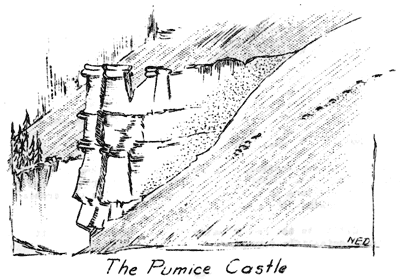|
Volume XI No. 2 - August, 1938
The Pumice Castle
By Wayne E. Kartchner, Ranger Naturalist and
John E. Doerr, Jr., Park Naturalist

Of the many colorful volcanic formations in the walls surrounding
Crater Lake, The Pumice Castle, on the east wall, attracts the attention
of all visitors making the launch trip around the lake, and of many
visitors viewing the crater walls from the rim, particularly when the
afternoon sunlight emphasizes the pattern of color on the east wall.
The Pumice Castle is part of an extensive lenticular bed of
fragmental pumice outcropping on the crater wall about 1,300 feet above
the level of the lake, or 400 feet below the crater rim just south of
Cloudcap. The bed of pumice has a maximum thickness of 190 feet. Below
it much of the section of the crater wall is hidden by talus, except for
a few thin layers of lava and beds of fragmental material. Immediately
above the lenticular bed of pumice is a thick, massive bed of andesite.
Above the andesite occurs the pumice which mantles the remnants of
Ancient Mount Mazama and the region extending for many miles beyond.
Following is a measured section from the top to the bottom of The
Pumice Castle.
4 feet of brownish red fragmental pumice
2 feet of light buff to pink fragmental pumice
4 feet of brownish red fragmental pumice
60 feet of gray fragmental pumice
60 feet of reddish brown fragmental pumice
6 feet of black obsidian
30 feet of brownish red fragmental pumice
4 feet of brown andesite containing numerous small lenses of black obsidian
20 feet of reddish brown fragmental pumice
A study of the section, composed of layers of hard, resistant
material such as the andesite and obsidian interspersed in the soft,
less resistant layers of fragmental pumice, explains why erosion has
produced the castle-like feature.
In addition to the scenic value of The Pumice Castle, it is a
significant scientific feature in that it is evidence of a pumice
eruption which occurred earlier than the ejection of material
represented by the great thickness of pumice exposed at the top of the
crater wall, and which mantles the region of miles beyond the crater
rim.
Beds of fragmental pumice, similar to that exposed at The Pumice
Castle, are exposed at several places in the north wall. At the Llao
Rock flow and at Palisade Point the pumice occurs beneath thick lava
flows. Whether these lenticular outcrops of pumice are of the same age,
or represent material ejected during one eruption, has as yet not been
determined. Field studies to date suggest that they represent material
ejected during one eruption. From further field studies it may be
possible to determine not only whether the pumice was ejected during one
eruption but also to determine the approximate location of the vent or
vents from which the material was ejected.
The Pumice Castle, the product of volcanic activity and erosion,
exemplifies the combination of scenic and scientific values typical of
Crater Lake, scenic in that its coloring and architecture stimulate the
imagination, scientific in that it tells part of the story of the
building and destruction of Mount Mazama.

| 
